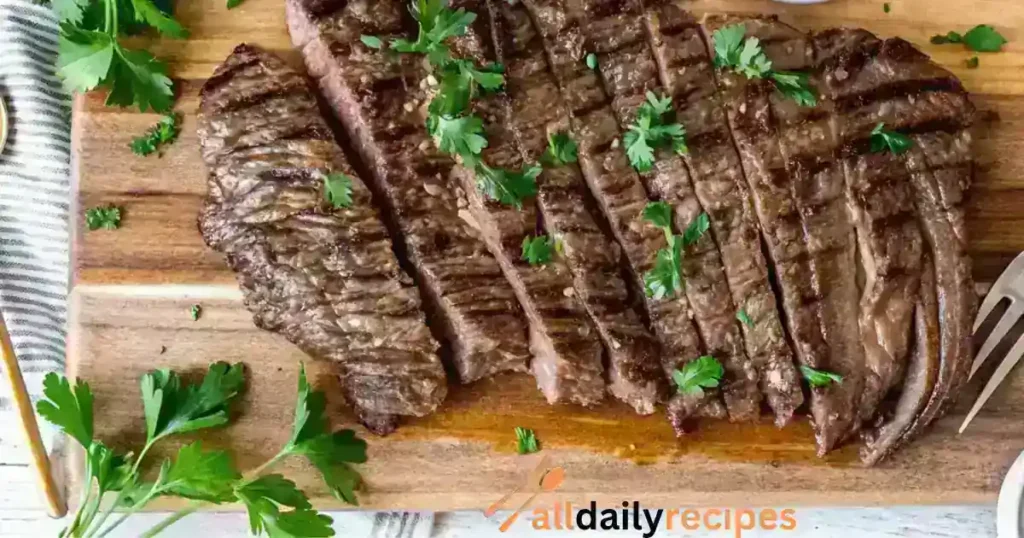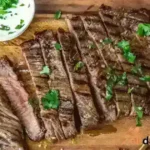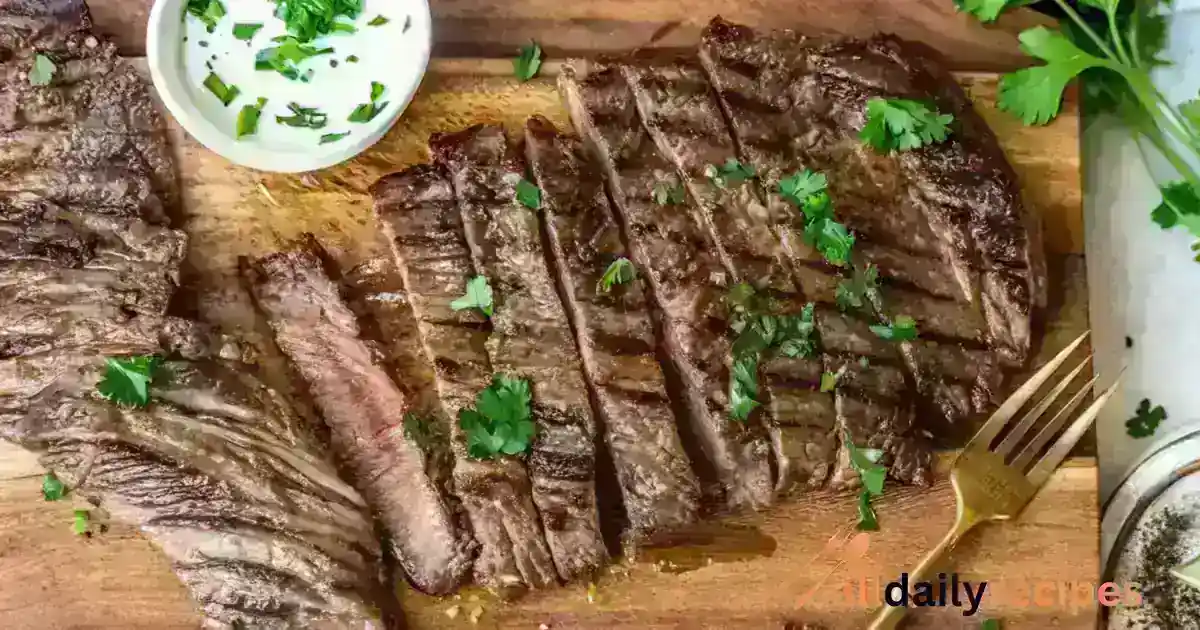There’s something oddly satisfying about finding a cut of meat that feels like a secret not hidden exactly, just… overlooked. Beef skirt meat is one of those cuts. If you’ve ever stood in front of the butcher’s counter and passed it by for something more familiar, you’re not alone. Most people do.
But here’s the thing: while others chase after ribeyes and filets, skirt meat quietly delivers an experience that’s hard to forget once you’ve had it done right. It’s bold. It’s fast. And when you hit the sweet spot that perfectly blistered sear, those juicy, thin-sliced ribbons it suddenly makes sense why chefs love it and why it shows up in some of the most crave-worthy dishes.
Now, full disclosure: it’s not a beginner’s cut in the way a boneless chicken breast is. If you cook it like a thick steak, you’ll probably be disappointed. But treat it on its terms high heat, quick cook, slice across the grain and you’ll wonder why this wasn’t always your go-to.
That’s what we’re getting into here. We’ll walk through what beef skirt meat actually is (it’s probably not what you think), how to make it tender without babying it, and all the ways to turn it into something seriously satisfying. Whether you’re here to fix a fajita faux pas or you’re just steak-curious, this is your map to mastering one of beef’s most flavorful cuts. Let’s dig in.
Table of Contents
What Is Beef Skirt Meat (and Why You Should Care)?
If beef cuts were characters at a dinner party, skirt meat would be the loud, confident guest holding court all charisma, no pretense. It’s not the most photogenic, but it knows who it is: bold, rugged, unapologetically flavorful.
Technically, beef skirt meat comes from the plate section of the cow a long, flat, ribbon-like muscle that sits just below the ribs and behind the brisket. It’s known for its pronounced grain and loose, ropey texture. And unlike those prim-and-proper steaks that rely on marbling, skirt meat brings its flavor through pure beef intensity and a touch of chew the good kind, the kind that makes your jaw say, “Yep, this is meat.”
Here’s what’s wild: there are actually two kinds of skirt meat outside and inside. Most people don’t realize this, but it matters.
- Outside Skirt: This is the cut you want if you can find it. It’s longer, narrower, and more uniform in shape. But the real difference? Texture. Outside skirt is more tender, with less sinew and a finer grain. Chefs love it because it cooks evenly and slices beautifully.
- Inside Skirt: Thicker, wider, and tougher. You’ll often find this one folded up in grocery packaging. It needs a bit more TLC a quick pounding, a solid marinade but it can still deliver fantastic results if you know what you’re working with.
Not sure which one you’ve got? That’s okay even some butchers aren’t clear unless you ask. One tip: if it’s thicker and feels a bit chewy when raw, it’s likely inside skirt. If it’s thinner, tighter-grained, and more pliable, congrats you’ve scored the good stuff.
The key is knowing how to handle whatever cut you get. Because whether you’re grilling, pan-searing, or throwing it in a screaming-hot cast iron skillet, this isn’t the kind of meat you can ignore. But that’s also why it’s fun.
Is skirt meat the same as flank steak?
Nope they’re neighbors on the cow, but not twins. Flank steak comes from the abdominal muscle near the rear, while skirt is from the plate near the ribs. Flank is thicker, leaner, and less intensely flavored. Skirt’s all about rich beefy taste and a more open texture. Think of flank as the introvert and skirt as the extrovert of the steak world.
Ingredients
- 1 pound beef skirt meat (inside or outside)
- 1 teaspoon kosher salt (adjust to taste)
- 1/2 teaspoon freshly ground black pepper
- 1 tablespoon high-smoke-point oil (like avocado or grapeseed)
- Optional: lime wedges, chimichurri, or your favorite finishing sauce

Instructions
- Bring to room temperature
Let the meat sit out for about 15 minutes before cooking. Cold meat in a hot pan tightens too fast and cooks unevenly. - Dry thoroughly
Use paper towels to remove any surface moisture. This helps the crust develop properly when it hits the pan. - Season boldly
Sprinkle salt and pepper generously on both sides. You don’t need to overthink it, just season it like you mean it. - Heat your pan
Use a heavy skillet, preferably cast iron. Preheat it over high heat for at least 3 minutes, until very hot. Add the oil and let it shimmer. - Sear without fear
Place the steak into the pan carefully. Let it sear undisturbed for 2 to 4 minutes on the first side, depending on thickness. Flip and cook the other side for another 2 to 3 minutes. Aim for medium-rare, about 130°F inside. - Let it rest
Remove from the pan and cover loosely with foil. Let it rest for 10 minutes. This is crucial to keep it juicy. - Slice across the grain
Always cut against the direction of the muscle fibers, at a slight angle. Thin slices are key to tenderness.
Serve it fresh and hot with lime, sauce, or just as it is. Skirt steak doesn’t need much to impress.
How to Cook Beef Skirt Meat So It’s Tender and Juicy
Cooking beef skirt meat is less about following a recipe and more about learning how the cut behaves. It’s got attitude. A bit of swagger. If you treat it like a thick, slow-cooking steak, you’ll end up disappointed. But if you go with its rhythm hot, fast, sharp it gives back in spades. Here’s what I do, and why it works.
First, I get the meat as dry as I can. Paper towels, every surface. It’s not about neatness moisture on the outside kills the crust. That golden sear we all chase? It needs dry contact. Wet steak just steams. It won’t brown. It won’t bark.
Then, heat. Not medium. Not high-ish. Blistering. I use a cast iron pan when I can because it holds heat better than anything else in my kitchen. Three minutes preheat. A splash of oil something neutral and then the meat goes in. No fiddling. No flipping yet. I press it gently to get full contact, then I wait.
Two minutes. Maybe three. It depends on the thickness, and honestly, I go by sound and smell more than a timer. It should hiss, not spit. The edge should start to fray just a little that’s a good sign.
Once it’s flipped, same story. But here’s where most people go wrong they keep it on too long. Skirt steak turns tough when it goes past medium. I aim for a center that’s warm red, not hot pink. Internal temp? About 130 degrees Fahrenheit. I check with a thermometer sometimes, but usually, it’s muscle memory.
Resting matters. Ten minutes. Foil-tented. That pause? It keeps the juices in, and it makes slicing easier. And speaking of slicing always across the grain. I hold the knife at a bit of an angle, just to lengthen the slices. It looks better. Eats better too.
If you mess up and it turns out tough? Slice it thinner. Serve it with sauce. It happens. Skirt steak is forgiving that way not perfect, but honest.
Can you slow-cook skirt meat instead?
Technically, yes. But you’d be forcing it into a role it’s not built for. Skirt steak shines when it’s kissed by high heat and handled quickly. Slow-cooking often just turns it limp and stringy. Better to stick with a fast sear and a good knife.
Marinating Beef Skirt Meat for Maximum Flavor
Here’s the truth: beef skirt meat doesn’t need a marinade but it definitely loves one. You can get a perfectly tasty result with just salt, pepper, and a hot pan. Still, when you’ve got a few extra minutes and the right ingredients on hand, marinating can unlock something special.
Skirt meat is built for it. The surface isn’t smooth like a filet. It’s rugged, all ridges and texture, which means more space for flavor to catch and cling. And because the cut is thin, it doesn’t take long to absorb what you give it. You’re not waiting hours. You’re giving it a quick coat of personality.
I usually aim for 20 to 30 minutes. That’s enough. Anything beyond that, especially with acidic ingredients like lime or vinegar, starts to mess with the texture. You’ll notice the surface turning pale and kind of soft that’s the acid starting to “cook” the meat. Not ideal, unless you’re making something like ceviche (and you’re not).
Some of my favorite marinades are the ones that don’t try too hard. Soy sauce, lime juice, garlic, and a little brown sugar? You get salt, acid, umami, and a bit of char when it hits the pan. Or try olive oil with rosemary and cracked pepper if you want something a little more grounded. There’s no one right answer here just a few base notes and a couple flavor high-fives.
Dry rubs work too, and they’re faster. The crust they form can be amazing. But either way, always dry the meat before you cook it. Even after marinating. That liquid might smell great, but on the pan, it turns into steam, not flavor.
And if you forget to marinate or don’t have the time? No panic. This cut brings plenty to the table on its own.
Is marinating skirt steak necessary?
Not really. It helps, but it’s not required. Skirt meat already has big flavor. Marinating is just one way to shape that flavor into something specific. If you’re working with great seasoning or a bold sauce, a simple sear will do just fine.
Genius Ways to Serve Beef Skirt Meat
Once you’ve nailed the cook, the question becomes what to do with it. And honestly, this is where beef skirt meat starts to shine in ways that might surprise you. It’s not just for fajitas. It can anchor a meal, play supporting role in a bowl, or turn leftovers into something you actually look forward to eating.
Let’s start with the obvious. Sliced, rested, and served with something sharp like chimichurri or salsa verde that’s classic. The brightness of herbs and vinegar cuts through the richness of the meat, and the contrast just works. Keep it simple. A pile of roasted potatoes or grilled vegetables on the side, and you’re already winning.
But don’t stop there. Skirt meat belongs in warm tortillas with sautéed onions and peppers, sure, but it’s just as good over a bed of greens with a vinaigrette that bites a little. I’ve tossed it into rice bowls with avocado, beans, and roasted corn. Or layered it into a sandwich with pickled onions and something creamy like aioli. The texture holds up. The flavor doesn’t fade into the background.
Breakfast is underrated here. Thin slices of skirt steak next to a runny egg, some toast, maybe a little spinach it’s quick, satisfying, and somehow feels like you put in more effort than you actually did.
And if you’ve got leftovers? Chop them. Toss them into quesadillas, hash, tacos, or even fried rice. A small amount goes a long way, and it carries flavor even when reheated.
The real trick is matching intensity. Skirt meat is bold. So it pairs best with foods that have edge think citrus, spice, char, crunch. It doesn’t need anything fancy. Just something honest.
Can I meal prep with skirt meat?
Absolutely. Just cook it slightly under your target doneness so it reheats well. Store it sliced or whole, and add it to meals throughout the week. It holds flavor and texture better than most cooked meats when stored properly.
Conclusion
There’s something satisfying about getting to know an underrated cut like beef skirt meat not just reading about it, but cooking it, slicing it right, tasting the depth of flavor it holds. It’s the kind of steak that doesn’t need to prove itself. Once you get it right, it speaks for itself.
What makes skirt meat special isn’t just the quick cook time or the bold texture. It’s how it invites creativity. One night it’s the center of a simple seared plate with veggies. The next, it’s tucked into tacos or layered into a sandwich you actually look forward to. You don’t need to do much just trust the process, keep the heat high, and don’t forget to slice against the grain.
If this is your first time trying it, don’t stress. Even if it doesn’t come out perfect, you’ll learn something. And when it does? You’ll probably be telling someone else about this “secret cut” that’s way too good to stay overlooked.
Let me know how it goes. And if you find a flavor combo or serving idea that surprises you, bookmark it this is the kind of cut you come back to.
FAQs About Beef Skirt Meat
Is beef skirt meat the same as flank steak?
No, but they’re often confused. Skirt meat comes from the plate section, while flank steak is cut from the abdominal area. Flank is thicker and has a tighter grain. Skirt is thinner, looser, and packs more beefy intensity. If you’re choosing based on flavor, skirt usually wins. If you want something lean and a little firmer, flank’s the way to go.
Why does my skirt meat always turn out chewy?
The most common reason is overcooking. Skirt steak needs high heat and short cook time. Once it goes past medium, the texture starts to fall apart in the wrong way. The other culprit? Slicing with the grain instead of across it. That’s a fast track to jaw fatigue.
Can I use beef skirt meat in stir-fry or other fast recipes?
Yes, and it’s actually a great choice. Just slice it thin before cooking and give it a short marinade. It works well in Korean BBQ, teriyaki, or anything with bold sauces and fast pan time. The key is speed once it hits the heat, don’t walk away.
Is it okay to freeze skirt meat?
Definitely. Skirt meat freezes and thaws well, especially when vacuum-sealed or tightly wrapped. If you’re freezing it raw, you can even add a marinade before sealing. If it’s already cooked, slice it before freezing so you can reheat just what you need.
What if I don’t have a cast iron pan?
You can still make it work. A heavy-bottomed stainless steel pan is your next best bet. Just avoid non-stick it can’t get hot enough to sear properly. If you’ve got a grill, even better. High heat and fast contact are what matter most.

Beef Skirt Steak
Ingredients
Method
- Let the meat sit out for about 15 minutes before cooking to reach room temperature.
- Use paper towels to remove any surface moisture from the meat.
- Sprinkle salt and pepper generously on both sides of the meat.
- Preheat a heavy skillet, preferably cast iron, over high heat for at least 3 minutes, then add oil.
- Carefully place the steak into the pan and let it sear undisturbed for 2 to 4 minutes, depending on thickness.
- Flip the steak and cook the other side for another 2 to 3 minutes, aiming for medium-rare at about 130°F internal temperature.
- Remove from the pan and cover loosely with foil, allowing it to rest for 10 minutes.
- Slice the steak against the grain at a slight angle for tenderness.
- Serve the steak fresh and hot with lime, sauce, or just as is.

